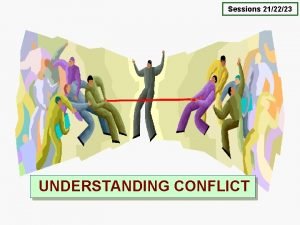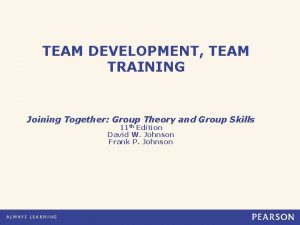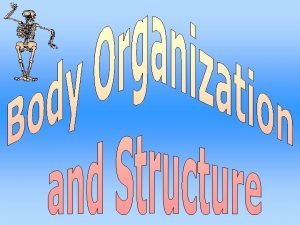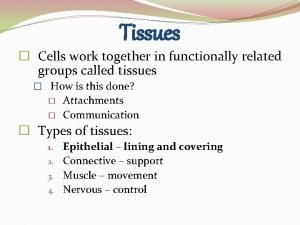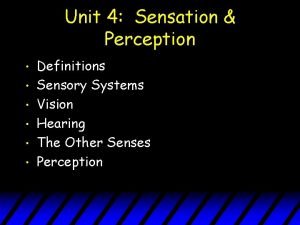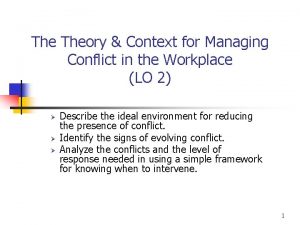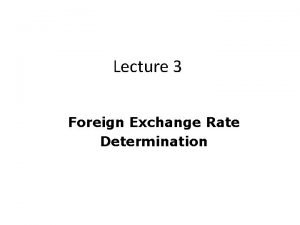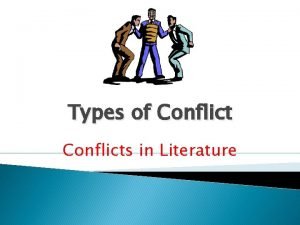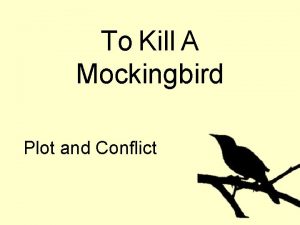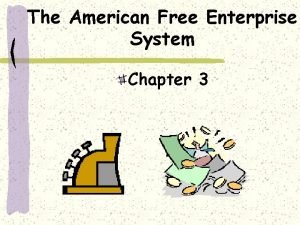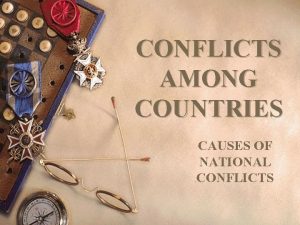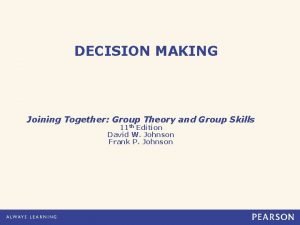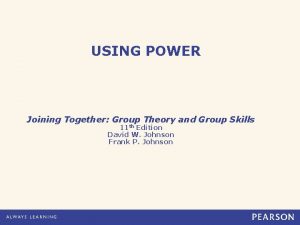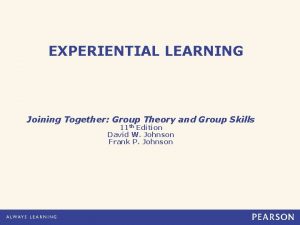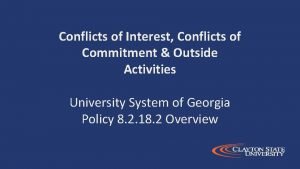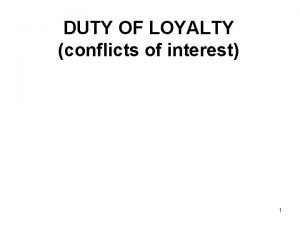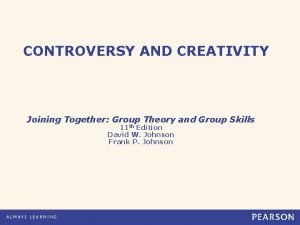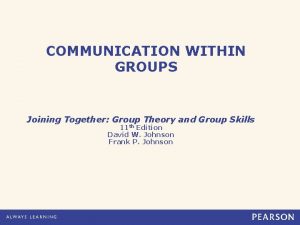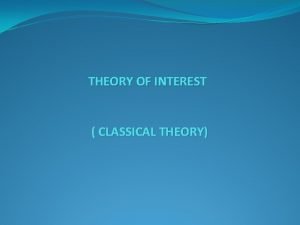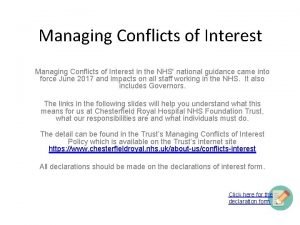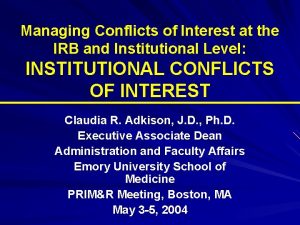MANAGING CONFLICTS OF INTEREST Joining Together Group Theory




























- Slides: 28

MANAGING CONFLICTS OF INTEREST Joining Together: Group Theory and Group Skills 11 th Edition David W. Johnson Frank P. Johnson

Chapter Nine: Objectives Understand That Groups Need To Have A Conflict Positive Orientation Understand Nature Of Conflict Of Interests And Positive Resolutions Understand In A Conflict There Are Two Concerns: Achieving Goals, Maintaining Relationships Understand The Five Strategies For Managing Conflicts Understand How To Control The Occurrence Of Conflicts Understand The Nature Of Negotiations And The Two Types Understand The Steps Of Integrative Negotiations Understand How Intergroup Conflict May Be Resolved Through Superordinate Goals, Decategorizing, Recategorization Into A Common Identity Understand Contact Theory Refine Skills In Resolving Conflicts Constructively Johnson. Joining Together: Group Theory and Group Skills, 11 e. © 2013, 2009, 2006, 2003, 2000 by Pearson Education, Inc. All Rights Reserved 9 -2

Conflict Positive Group: Conflicts Are Encouraged And Managed Constructively To Enhance Group Effectiveness. Focus On Problem Solving. Conflict Negative Group: Conflicts Are Denied, Suppressed, And Avoided And Managed Destructively. Focus On Winning. Johnson. Joining Together: Group Theory and Group Skills, 11 e. © 2013, 2009, 2006, 2003, 2000 by Pearson Education, Inc. All Rights Reserved 9 -3

What Is Conflict? Dictionary: A Disagreement, Dispute, Quarrel, Struggle, Fight, Battle Deutsch: • Whenever Incompatibility Activities Occur; • Activities Are Incompatible When They Prevent, Block, Interfere With The Occurrence Of Each Other Johnson. Joining Together: Group Theory and Group Skills, 11 e. © 2013, 2009, 2006, 2003, 2000 by Pearson Education, Inc. All Rights Reserved 9 -4

Conflict Of Interests Want: Desire For Something Need: Universal Necessity For Survival Goal: Desired Ideal State Of Future Affairs Interests: Potential Benefits To Be Gained By Achieving Goals Conflict Of Interests: Actions Taken By Person A To Achieve Goals Prevent, Block, Or Interfere With Actions Taken By Person B To Achieve Goals Johnson. Joining Together: Group Theory and Group Skills, 11 e. © 2013, 2009, 2006, 2003, 2000 by Pearson Education, Inc. All Rights Reserved 9 -5

Constructive Resolution Of Conflicts Agreement That Maximizes Joint Outcomes And Is In All Participants’ Best Interests Relationship Is Improved Ability To Resolve Future Conflicts Improved Johnson. Joining Together: Group Theory and Group Skills, 11 e. © 2013, 2009, 2006, 2003, 2000 by Pearson Education, Inc. All Rights Reserved 9 -6

Aggression: Physical Or Verbal Behavior Intended To Injure Another • Direct: Behavior Aimed At Hurting Another Person To His Or Her Face • Indirect: Behavior Aimed At Hurting Another Without Obvious Face-To-Face Conflict • Emotional: Hurtful Behavior Stemming From Out-Of-Control Anger • Instrumental: Hurting Another To Achieve A Goal • Displaced: Hurtful Behavior Toward A Person Who Is Not The Causal Agent Of The Provocation • Vicarious: Hurtful Behavior Toward Outgroup Members For Provocation That Had No Personal Consequences But Harmed Fellow Ingroup Member Frustration-Aggression: Frustration From Failure To Achieve Goals Results In Readiness To Respond In Aggressive Ways Johnson. Joining Together: Group Theory and Group Skills, 11 e. © 2013, 2009, 2006, 2003, 2000 by Pearson Education, Inc. All Rights Reserved 9 -7

In Conflicts There Are Two Concerns: Your Goals Unimportant 1 – 2 – 3 – 4 – 5 Important Your Relationship With The Other Person(s) Unimportant 1 – 2 – 3 – 4 – 5 Important Johnson. Joining Together: Group Theory and Group Skills, 11 e. © 2013, 2009, 2006, 2003, 2000 by Pearson Education, Inc. All Rights Reserved 9 -8

Strategies Diagram Johnson. Joining Together: Group Theory and Group Skills, 11 e. © 2013, 2009, 2006, 2003, 2000 by Pearson Education, Inc. All Rights Reserved 9 -9

Five Basic Strategies Problem-Solving Negotiations Smoothing Compromise Forcing Withdrawal Johnson. Joining Together: Group Theory and Group Skills, 11 e. © 2013, 2009, 2006, 2003, 2000 by Pearson Education, Inc. All Rights Reserved 9 -10

Considerations For Using Strategies To Be Competent In Managing Conflicts, You Must Be Able To Engage In All Five Strategies Some Strategies May Be Enacted Alone, Others Require The Participation Of The Other Disputant The Strategies Tend To Be Incompatible Certain Strategies May Deteriorate Into Other Strategies Whether Problem Solving Or Forcing Is Used Depends On Your Perception Of The Future Of The Relationship • Shadow Of Future Looms Largest When Interactions Are Durable And Frequent Johnson. Joining Together: Group Theory and Group Skills, 11 e. © 2013, 2009, 2006, 2003, 2000 by Pearson Education, Inc. All Rights Reserved 9 -11

Rules For Conflict Strategies Do Not Withdraw Or Ignore Do Not “Win” Assess For Smoothing Compromise When Time Is Short Engage In Problem-Solving Negotiations Use Your Sense Of Humor Johnson. Joining Together: Group Theory and Group Skills, 11 e. © 2013, 2009, 2006, 2003, 2000 by Pearson Education, Inc. All Rights Reserved 9 -12

Controlling Occurrence Of Conflict Circumstances: • Barriers To Engaging In The Conflict: – Internal: Attitudes, Values, Habit Patterns – External: Tasks, Group Norms, Public Pressure, Physical Separation • Events That Trigger The Conflict Entry State: Person’s Ability To Deal Constructively With Conflict • Level Of Self-Awareness • Ability To Control Behavior • Communication Skills • Negotiation Skills Johnson. Joining Together: Group Theory and Group Skills, 11 e. © 2013, 2009, 2006, 2003, 2000 by Pearson Education, Inc. All Rights Reserved 9 -13

Negotiations Process By Which Persons Who Have Shared And Opposed Interests And Want To Come To An Agreement Try To Decide On A Settlement Win-Lose (Distributive): Each Negotiator Has The Goal Of Reaching An Agreement More Favorable To Oneself Than To The Other Negotiator • Competitive Context • Short-Term Self-Interest Problem-Solving (Integrative): Each Negotiation Has The Goal Of Reaching An Agreement That Benefits Everyone Involved • Cooperative Context • Long-Term Mutual Interest Johnson. Joining Together: Group Theory and Group Skills, 11 e. © 2013, 2009, 2006, 2003, 2000 by Pearson Education, Inc. All Rights Reserved 9 -14

Important Points About Negotiations Interdependence In Negotiations: • Participation: It Takes Two To Negotiate • Outcome: It Takes Two To Agree • Information: Depend On Other For Information – Dilemma Of Trust: Believe Or Not Believe – Dilemma Of Honesty: Tell Truth Or Not Mixed Motive Situation: Both Cooperative And Competitive Elements Attend To Both Primary And Secondary Gains Contractual Norms • Norm Of Reciprocity: Reciprocate Other’s Actions • Norm Of Equity: Benefits & Costs Should Be Equal Time Dimensions: Beginning, Middle, End (Tactics Differ) Goal Dilemma: Propose Agreement Favorable To Oneself But Not So One-Sided Other Refuses To Agree Johnson. Joining Together: Group Theory and Group Skills, 11 e. © 2013, 2009, 2006, 2003, 2000 by Pearson Education, Inc. All Rights Reserved 9 -15

Distributive Negotiations Goal Is To Maximize Own Outcomes And Minimize Other’s Outcomes Trigger Conflict At Time Advantageous For You Make An Extreme Opening Offer Compromise Slowly To Create Tough Image, Influence Other’s Expectations Use Threats, Promises, Take Preemptive Action, Be Persuasive, Commit To Unalterable Position Be Willing To Walk Away With No Agreement Johnson. Joining Together: Group Theory and Group Skills, 11 e. © 2013, 2009, 2006, 2003, 2000 by Pearson Education, Inc. All Rights Reserved 9 -16

Integrative Negotiations Goal Is To Maximize Joint Benefits, Reach Agreement That Benefits All Participants One-Step Negotiations: 1. Assess Own Interests 2. Assess Other’s Interests 3. Whoever Has Most Important Interests At Stake Gets His Or Her Way Procedure: 1. Explain What You Want 2. Describe How You Feel 3. Explain Your Reasons For Your Wants & Feelings 4. Reverse Perspectives, Summarize Other’s Wants, Feelings, Reasons 5. Invent Three Or More Optional Agreements That Maximize Joint Outcomes 6. Choose Agreement That Seems Wisest Johnson. Joining Together: Group Theory and Group Skills, 11 e. © 2013, 2009, 2006, 2003, 2000 by Pearson Education, Inc. All Rights Reserved 9 -17

Integrative Negotiation Procedure 1 Explain What You Want: • Describe What You Want • Listening To Other’s Wants • Describe Other’s Actions • Define Conflict As Mutual Problem • Define Conflict As Being Small & Specific Describe Your Feelings • Many Conflicts Cannot Be Resolved Unless Feelings Are Recognized And Dealt With • Builds Close Relationships • Feelings Affect Perceptions, Judgments, Motivations Johnson. Joining Together: Group Theory and Group Skills, 11 e. © 2013, 2009, 2006, 2003, 2000 by Pearson Education, Inc. All Rights Reserved 9 -18

Integrative Negotiations Procedure 2 Exchange Reasons For Positions • Express Cooperative Intentions • Present Your Reasons, Listen To Other’s Reasons • Focus On Wants And Interests, Not Positions • Differentiate Before Integrating • Empower The Other Person • Stay Flexible • Coordinate Motivation To Negotiate In Good Faith Understand Other’s Perspective • Each Person Has Unique Perspective • Perspective Determines & Organizes Perceptions • Person Has Different Perspectives At Different Times • A Message Is Interpreted Differently From Different Perspectives • Misunderstandings Result When One Assumes Others Share One’s Perspective Johnson. Joining Together: Group Theory and Group Skills, 11 e. © 2013, 2009, 2006, 2003, 2000 by Pearson Education, Inc. All Rights Reserved 9 -19

Integrative Negotiations Procedure 3 Invent Options For Mutual Gain • Avoiding Obstacles • Invent Creative Options Reach Wise Agreement • Be Fair And Meet Legitimate Goals Of Participants • Specify Responsibilities And Rights Of Everyone Involved: – How Each Person Will Act Differently In Future – How Agreement Will Be Reviewed And Renegotiated If Necessary – Improve Relationship Among Participants – Strengthen Participants Ability To Resolve Future Conflicts – Based On Principals Justified By Objective Criteria Johnson. Joining Together: Group Theory and Group Skills, 11 e. © 2013, 2009, 2006, 2003, 2000 by Pearson Education, Inc. All Rights Reserved 9 -20

Negotiating Steps I Want I Feel My Reasons Are My Understanding Of You Is Three Plans Are Let’s Choose Plan B. Shake. Johnson. Joining Together: Group Theory and Group Skills, 11 e. © 2013, 2009, 2006, 2003, 2000 by Pearson Education, Inc. All Rights Reserved 9 -21

Intergroup Conflict Muzafer Sherif, Robber’s Cave Studies: Conflict Resolution Strategies • Participate In Pleasant Situations • Establishment Of Common Enemy • Superordinate Goals: Compelling Goals That One Group Cannot Achieve Alone Robert Blake & Jane Mouton: • Before Negotiations • During Negotiations • After Negotiations • Win-Lose Dynamic • Psychodynamic Fallacy • Self-Fulfilling Prophecy Johnson. Joining Together: Group Theory and Group Skills, 11 e. © 2013, 2009, 2006, 2003, 2000 by Pearson Education, Inc. All Rights Reserved 9 -22

Distinction Between “Us” And “Them” Intergroup Competition Ingroup-Outgroup Bias: We Have More Favorable Views Of Groups To Which We Belong Social Identity And Social Categorization Theories Decategorization: Personalizing Interaction Recategorization: Building A Common Ingroup Identity Johnson. Joining Together: Group Theory and Group Skills, 11 e. © 2013, 2009, 2006, 2003, 2000 by Pearson Education, Inc. All Rights Reserved 9 -23

Contact Theory Cooperative (As Opposed To Competitive And Individualistic) Efforts Personal (As Opposed To Impersonal) One-On-One (As Opposed To Group) Interactions Support (As Opposed To Opposition) From Social Norms And Authorities For Contact Equal (As Opposed To Unequal) Status Johnson. Joining Together: Group Theory and Group Skills, 11 e. © 2013, 2009, 2006, 2003, 2000 by Pearson Education, Inc. All Rights Reserved 9 -24

Additional Conditions Salience Of Social Categories. Salience May Be Reduced By: • Making Shared Categories Relevant • Equal Representation Of Groups • Common Identity Intergroup Friendship Johnson. Joining Together: Group Theory and Group Skills, 11 e. © 2013, 2009, 2006, 2003, 2000 by Pearson Education, Inc. All Rights Reserved 9 -25

Problems With Contact Theory Proliferation Of Required Conditions Makes Theory Meaningless Lack Of Specificity Of How Contact Results In Positive Relationships (Social Judgment Theory Addresses This Issue) Individual-To-Individual (Not Group-To-Group) Focus Johnson. Joining Together: Group Theory and Group Skills, 11 e. © 2013, 2009, 2006, 2003, 2000 by Pearson Education, Inc. All Rights Reserved 9 -26

Mediation 1. Mediation Exists When An Impartial Third Party Assists Two Or More People In Negotiating A Constructive Resolution To Their Conflict. 2. Arbitration: Binding Settlement Of A Conflict Determined By A Disinterested Third Party Johnson. Joining Together: Group Theory and Group Skills, 11 e. © 2013, 2009, 2006, 2003, 2000 by Pearson Education, Inc. All Rights Reserved 9 -27

Major Points Groups Need To Have A Conflict Positive Orientation In A Conflict Of Interests There Are Two Concerns: Achieving Goals, Maintaining Relationships There Are Five Strategies To Manage Conflicts (Forcing, Withdrawing, Smoothing, Compromising, Problem Solving) Occurrence Of Conflict May Be Controlled By Circumstances & Entry States There Are Two Types Of Negotiations (Distributive & Integrative) Integrative Negotiations Has Six Steps (Explain Wants, Describe Feelings, Explain Reasons, Reverse Perspectives, Create Optional Agreements, Select One) Intergroup Conflict May Be Resolved Through Superordinate Goals, Decategorizing, Recategorization Into A Common Identity Contact Theory Provides Framework For Reducing Intergroup Conflict (Cooperation, Personal Interactions, Support From Authorities, Equal Status) Johnson. Joining Together: Group Theory and Group Skills, 11 e. © 2013, 2009, 2006, 2003, 2000 by Pearson Education, Inc. All Rights Reserved 9 -28
 Joining together group theory and group skills
Joining together group theory and group skills Dimensions of conflict handling intentions
Dimensions of conflict handling intentions Joining together as a team to improve the quality
Joining together as a team to improve the quality Nominal v. real interest rates
Nominal v. real interest rates Nominal.interest rate
Nominal.interest rate Compound interest multiplier
Compound interest multiplier Opvoedbelasting
Opvoedbelasting Apa itu interest group institusional
Apa itu interest group institusional Interest groups free rider problem
Interest groups free rider problem This is a group of lines in a poem
This is a group of lines in a poem It involves people living together in a community. *
It involves people living together in a community. * A group of islands clustered together
A group of islands clustered together Cells working together form
Cells working together form A group of islands clustered together are called
A group of islands clustered together are called Interrupt descriptor table
Interrupt descriptor table Cells group together to form
Cells group together to form Group of cells working together
Group of cells working together Internal rhyme examples
Internal rhyme examples What is a group of organs working together
What is a group of organs working together The perceptual tendency to group together stimuli
The perceptual tendency to group together stimuli Insert clustered column chart
Insert clustered column chart Managing conflict theory
Managing conflict theory Purchasing power parity formula
Purchasing power parity formula Interest rate parity
Interest rate parity Definition external conflict
Definition external conflict Conflict in to kill a mockingbird
Conflict in to kill a mockingbird To kill a mockingbird conflicts
To kill a mockingbird conflicts Government's role in a modified free enterprise economy
Government's role in a modified free enterprise economy Structural conflicts
Structural conflicts

